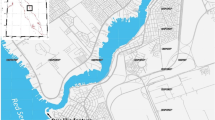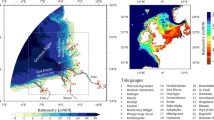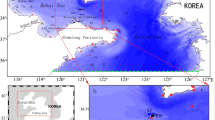Abstract
To model currents in a fjord accurate tidal forcing is of extreme importance. Due to complex topography with narrow and shallow straits, the tides in the innermost parts of a fjord are both shifted in phase and altered in amplitude compared to the tides in the open water outside the fjord. Commonly, coastal tide information extracted from global or regional models is used on the boundary of the fjord model. Since tides vary over short distances in shallower waters close to the coast, the global and regional tidal forcings are usually too coarse to achieve sufficiently accurate tides in fjords. We present a straightforward method to remedy this problem by simply adjusting the tides to fit the observed tides at the entrance of the fjord. To evaluate the method, we present results from the Oslofjord, Norway. A model for the fjord is first run using raw tidal forcing on its open boundary. By comparing modelled and observed time series of water level at a tidal gauge station close to the open boundary of the model, a factor for the amplitude and a shift in phase are computed. The amplitude factor and the phase shift are then applied to produce adjusted tidal forcing at the open boundary. Next, we rerun the fjord model using the adjusted tidal forcing. The results from the two runs are then compared to independent observations inside the fjord in terms of amplitude and phases of the various tidal components, the total tidal water level, and the depth integrated tidal currents. The results show improvements in the modelled tides in both the outer, and more importantly, the inner parts of the fjord.







Similar content being viewed by others
References
Albretsen J, Sperrevik AK, Staalstrøm A, Sandvik AD, Vikebø F, Asplin LC (2011) Norkyst-800 report no. 1: user manual and technical descriptions. Technical report fisken og havet 2/2011, Institute of Marine Research, Pb. 1870 Nordnes, N-5817 Bergen, Norway
Anon (2016) Tide tables for the Norwegian Coast with Svalbard and Dover, England [in Norwegian]. Technical report, Norwegian Mapping Authority
Baalsrud K, Magnusson J (1990) The state of eutrophication in the outer Oslofjord 1989 [in Norwegian]. Technical report, Norwegian Institute for Water Research
Beldring S, Engeland K, Roald LA, Sælthun NR, Voksø A (2003) Estimation of parameters in a distributed precipitation-runoff model for Norway. Hydrol Earth Syst Sci Discuss 7(3):304– 316
Bennett A, McIntosh P (1982) Open ocean modeling as an inverse problem: tidal theory. J Phys Oceanogr 12(10):1004–1018
Carniello L, Defina A, Fagherazzi S, D’alpaos L (2005) A combined wind wave–tidal model for the Venice Lagoon, Italy. J Geophys Res Earth Surf 110(F4)
Cartwright DE (1977) Oceanic tides. Rep Prog Phys 40(6):665
Chen P, Mellor GL (1999) Determination of tidal boundary forcing using tide station data. Coast Estuar Stud 329–352
Egbert GD, Bennett AF, Foreman MG (1994) Topex/poseidon tides estimated using a global inverse model. J Geophys Res Oceans (1978–2012) 99(C12):24821–24852
Egbert GD, Erofeeva SY (2002) Efficient inverse modeling of barotropic ocean tides. J Atmos Ocean Technol 19(2):183–204
Eliassen IK, Heggelund Y, Haakstad M (2001) A numerical study of the circulation in Saltfjorden, Saltstraumen and Skjerstadfjorden. Cont Shelf Res 21(15):1669–1689
Foreman M, Walters R (1990) A finite-element tidal model for the southwest coast of vancouver island. Atmosphere-Ocean 28(3):261–287
Gjevik B, Straume T (1989) Model simulations of the m2 and the k1 tide in the nordic seas and the arctic ocean. Tellus A 41(1):73–96
Glenne B, Simensen T (1963) Tidal current choking in the landlocked fjord of Nordåsvatnet. Sarsia 11 (1):43–73
Grabbe M, Lalander E, Lundin S, Leijon M (2009) A review of the tidal current energy resource in Norway. Renew Sust Energ Rev 13(8):1898–1909
Haidvogel DB, Arango H, Budgell WP, Cornuelle BD, Curchitser E, Di Lorenzo E, Fennel K, Geyer WR, Hermann AJ, Lanerolle L et al (2008) Ocean forecasting in terrain-following coordinates: formulation and skill assessment of the regional ocean modeling system. J Comput Phys 227(7):3595–3624
Hendershott MC (1981) Long waves and ocean tides. Evolution of Physical Oceanography 292–341
Hjelmervik KB, Staalstrøm A, Kristensen NM, Røed L. P. (2017) Evaluation of the Oslofjord model. Technical report 1, Norwegian Meteorological Institute, MET Norway, P.O.Box 43 Blindern, NO-0313 Oslo, Norway
Klinck JM, O’Brien JJ, Svendsen H (1981) A simple model of fjord and coastal circulation interaction. J Phys Oceanogr 11(12):1612–1626
Lynge BK, Hjelmervik K, Gjevik B (2013) Storm surge and tidal interaction in the Tjeldsund channel, Northern Norway. Ocean Dyn 63(7):723–739
Müller M, Homleid M, Ivarsson K-I, Køltzow MA, Lindskog M, Midtbø KH, Andrae U, Aspelien T, Berggren L, Bjørge D et al (2017) AROME-MetCoOp: a nordic convective-scale operational weather prediction model. Weather Forecast 32(2):609–627
Munk WH, Cartwright DE (1966) Tidal spectroscopy and prediction. Philos Trans R Soc Lond A Math Phys Eng Sci 259(1105):533–581
Oliveira AM, Kjerfve B (1993) Environmental responses of a tropical coastal lagoon system to hydrological variability: Mundau-Manguaba, Brazil. Estuar Coast Shelf Sci 37(6):575–591
Pawlowicz R, Beardsley B, Lentz S (2002) Classical tidal harmonic analysis including error estimates in matlab using t_tide. Comput Geosci 28(8):929–937
Rodhe J (1996) On the dynamics of the large-scale circulation of the Skagerrak. J Sea Res 35(1):9–21
Røed LP, Kristensen NM, Hjelmervik KB, Staalstrøm A (2016) A high-resolution, curvilinear roms model for the oslofjord. Technical report 4, Norwegian Meteorological Institute, MET Norway, P.O.Box 43 Blindern, NO-0313 Oslo, Norway
Rydberg L, Wickbom L (1996) Tidal choking and bed friction in Negombo Lagoon, Sri Lanka. Estuaries 19(3):540–547
Shchepetkin AF, McWilliams JC (2005) The regional oceanic modeling system (roms): a split-explicit, free-surface, topography-following-coordinate oceanic model. Ocean Model 9(4):347–404
Shchepetkin AF, McWilliams JC (2009) Correction and commentary for “ocean forecasting in terrain-following coordinates: Formulation and skill assessment of the regional ocean modeling system” by Haidvogel et al., J Comp Phys 227, pp 3595–3624. J Comput Phys 228(24):8985–9000
Staalstrøm A, Arneborg L, Liljebladh B, Broström G (2015) Observations of turbulence caused by a combination of tides and mean baroclinic flow over a fjord sill. J Phys Oceanogr 45(2):355–368
Staalstrøm A, Røed LP (2016) Vertical mixing and internal wave energy fluxes in a sill fjord. J Mar Syst 159:15–32
Stammer D, Ray R, Andersen OB, Arbic B, Bosch W, Carrère L, Cheng Y, Chinn D, Dushaw B, Egbert G et al (2014) Accuracy assessment of global barotropic ocean tide models. Rev Geophys 52(3):243–282
Stigebrandt A (1976) Vertical diffusion driven by internal waves in a sill fjord. J Phys Oceanogr 6:486–495
Stigebrandt A (1980) Some aspects of tidal interaction with fjord constrictions. Estuar Coast Mar Sci 11 (2):151–166
Svendsen E, Berntsen J, Skogen M, Ådlandsvik B, Martinsen E (1996) Model simulation of the skagerrak circulation and hydrography during skagex. J Mar Syst 8(3):219–236
Tryggestad S (1974) A survey of current conditions at brenntangen and tides in the Oslofjord [in Norwegian]. Technical report University of Oslo, Oslo, Norway
Unna P (1947) Sea waves. Nature 159:239–242
Zhang A, Wei E, Parker BB (2003) Optimal estimation of tidal open boundary conditions using predicted tides and adjoint data assimilation technique. Cont Shelf Res 23(11):1055–1070
Author information
Authors and Affiliations
Corresponding author
Additional information
Responsible Editor: Martin Verlaan
This article is part of the Topical Collection on the 18th Joint Numerical Sea Modelling Group Conference, Oslo, Norway, 10–12 May 2016
Rights and permissions
About this article
Cite this article
Hjelmervik, K., Kristensen, N.M., Staalstrøm, A. et al. A simple approach to adjust tidal forcing in fjord models. Ocean Dynamics 67, 949–958 (2017). https://doi.org/10.1007/s10236-017-1067-y
Received:
Accepted:
Published:
Issue Date:
DOI: https://doi.org/10.1007/s10236-017-1067-y




